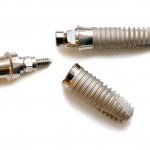
When placing dental implants axial placement is recommended to dissipate occlusal forces along the implants long axis to reduce stresses. However, this is not always possible because of anatomical considerations so the use of tilted implants may overcome these limitations. Although there is no consensus on the use of tilted implants for implant-supported fixed partial dentures.
The aim of this review was to evaluate the marginal bone loss and implant survival rate of tilted implants compared with those of axial implants for implant-supported fixed partial dentures (ISFPDs).
Methods
A review protocol was registered with PROSPERO. Searches were conducted in the Medline/PubMed, Embase, Cochrane Library, Web of Science and ProQuest databases with no language or date restrictions. Clinical intervention or observational studies evaluating tilted implants compared with axial implants for ISFPDs, with a minimum of 10 participants and 10 implants for each evaluated group were considered. Two reviewers selected studies with data being was abstracted by one review and cross-checked by a second with a third review resolving disagreements. Study quality was assessed using the Newcastle Ottawa Scale (NOS). Implant survival rates were presented as odds ratios (OR) with 95% confidence intervals (CIs) and marginal bone loss as mean difference with 95%CIs.
Results
- 9 studies involving a total of 258 patients and 604 implants (269 tilted, 335 axial) were included.
- Studies included between 10 to 60 patients and 20 to 160 implants.
- The mean follow-up period was 34.1 months (range 12 to 204 months).
- 6 of the studies used screw-retained prosthesis.
- All 9 studies scored 6 or more on the NOS indicating low risk of bias.
- No implant failures were reported in 4 of the 9 studies.
- Overall, a slightly higher proportion of failures were reported for tilted implants (2.23%) than axial implants (1.79%)
- Meta-analyses found: –
- No significant difference in survival between tilted and axial implants, OR = 1.14 (95%C: 0.40 to 3.27) [9 studies].
- Higher marginal bone loss for tilted implants, MD = 12 mm (CI: 0.05 to 0.19 mm) [8 studies].
Conclusions
The authors concluded: –
No significant relationship was found between tilted and axial implants for ISFPD rehabilitation. However, tilted implants presented greater risks of marginal bone loss than axial implants.
Comments
The authors registered their protocol with the PROSPERO databases and have searched a good range of relevant databases. The initial protocol question was broader aiming to compare bone loss and survival in tilted and axial implants with the aim of performing a subgroup analysis for type of prosthesis. The published review focuses on ISFPDs only. Of the included studies 4 were retrospective, 4 prospective and one cross-sectional. While the studies were considered to be of low risk of bias, all but two studies involved fewer than 30 patients with only 3 studies including patients with follow-up periods of 5 years or more. Given the relatively short follow up periods for the included studies the limited number of implant failures is not surprising. While a significant difference was noted for marginal bone loss between tilted and axial implants the difference is unlikely to be clinically significant, appoint noted by the authors. Larger well designed and reported prospective studies of longer duration are needed to improve the quality of evidence on this topic.
Links
Primary Paper
Batista RG, Faé DS, Bento VAA, Rosa CDDRD, Souza Batista VE, Pellizzer EP, Lemos CAA. Impact of tilted implants for implant-supported fixed partial dentures: A systematic review with meta-analysis. J Prosthet Dent. 2022 Dec 23: S0022-3913(22)00739-9. doi: 10.1016/j.prosdent.2022.11.015. Epub ahead of print. PMID: 36567158.
Other references
Dental Elf – 5th Dec 2014
Dental implants: are survival rates for tilted and axially placed implants similar?
